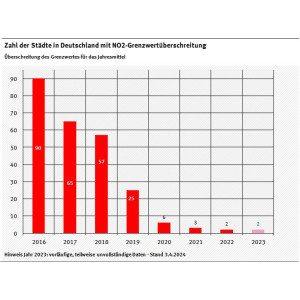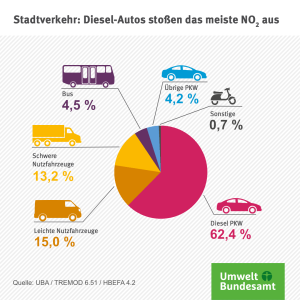Particulates and nitrogen dioxide pollution have continued to decrease. In 2020 there were six cities which exceeded the NO₂ limit value, whereas that number had reached 25 in 2019. The number of cities is expected to be fewer than five in 2021. An evaluation of data now available indicates that the cities of Munich and Ludwigsburg each had a measuring station that recorded annual averages above the limit value. An evaluation of final data and outstanding data from the roughly 115 passive samplers might possibly add a few cities to those with exceedances.
The main source of nitrogen oxides in urban areas is road traffic. Diesel cars in particular are emitters and have not been held to prove low emissions in real-time operation on the road. A steady renewal of the vehicle fleet has put more and more cleaner cars on urban roads. Local measures and fewer journeys as a result of measures to curb the COVID-19 pandemic also played a role in lowering NO₂ concentrations over the past two years.
Air pollutant emissions have all declined steadily in recent years. The latest complete data available is from 2020 and shows that Germany met its reduction commitments under the European NEC Directive (National Emission Reduction Commitments Directive). In 2020 emissions of ammonia were down by some 25 percent over 1990 levels, and particulate matter and nitrogen oxides showed 60 percent and nearly 66 percent reductions, respectively.
The World Health Organization WHO issued new Global Air Quality Guidelines last September. Scientific findings of the past 20 years prompted the WHO to adjust levels for pollutants including particulate matter and nitrogen dioxide downwards. Messner said: “The European Environment Agency (EEA) says that air pollution in the 27 EU Member States continues to be a considerable threat to health causing many premature deaths and diseases. Particulate matter poses the greatest threat: the EEA has traced the 53,800 premature deaths in Germany in 2019 to lasting exposure to particulate matter. Germany current exceeds nearly all of the WHO’s new guidelines. The EU Commission will make a proposal to amend the Air Quality Directive this autumn. The proposed limit values will be aligned with the WHO guidelines. Germany intends to support this amendment to the Ambient Air Quality Directive.”
Germany has a further commitment under the EU NEC Directive to make significant cuts in air pollutant emissions by 2030. The measures planned to achieve this goal are set down in the national clean air programme and will lead to improved air quality. However, an initial assessment by UBA indicates these measures will not be enough to achieve compliance with the WHO guideline values. Dirk Messner said: “For truly healthy air, pollution must be further reduced permanently and throughout Germany. There is urgent need for action beyond the measures already set down in the clean air programme. We must aim to make our air as clean as possible because the latest data from WHO proves that every microgram less air pollution is good for our health.”
 Click to enlarge
Click to enlarge












